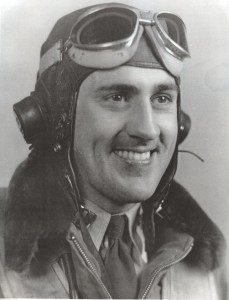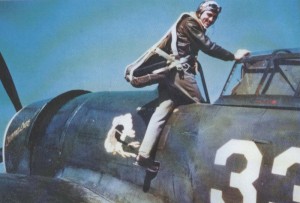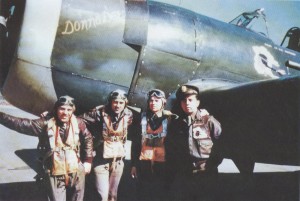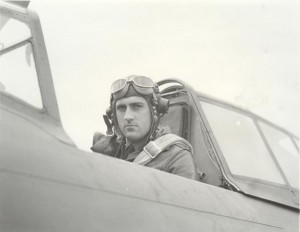
While with the 352nd Fighter Group, 486th Fighter Squadron, Stanley Miles flew 110 sorties and downed at least six German airplanes. He was awarded the Air Medal and Distinguished Flying Cross with Oak Leaf Cluster.
By Bill Stansbeary
Filling out “encounter reports” was part of the experience of being an American fighter pilot in World War II. Col. Stanley “Stan” Miles, now living in Centennial, Colo., recorded some of the most interesting close encounters with the enemy and death, while flying the North American P-51 Mustang.
On May 13, 1944, Miles, of the 352nd Fighter Group, 486th Fighter Squadron, had quite an eventful day. The “Blue Nosed Bastards of Bodney” were then based at a small grass Eighth Army Air Force base in East Anglia, Bodney, England, and were simply assigned bomber escort duty. What looked like an easy mission quickly turned interesting, as the German Luftwaffe showed up with a huge mass of more than 100 fighters to contest the skies over Tribsees, Germany.
“We had been with the bombers for maybe an hour with nothing unusual happening, then got a radio transmission that there was a big gaggle of more than 100 bandits headed our way,” Miles recalled. “As we got in over land a little ways, we got a transmission from Woodrow “Woody” Anderson, saying that he had spotted the bandits at 1 o’clock high. Sure enough, here they came.”
Miles’ encounter report detailed, “Just as I broke into the attack, an enemy belly tank that was released above me hit my left horizontal stabilizer, causing some damage.”
“We went through them, and they dropped their belly tanks,” Miles adds today. “One of these tanks tumbled down and hit my left horizontal stabilizer. It jammed something, so that I couldn’t climb, no matter how hard I pulled the stick back. I could do anything else, but not climb.”
Miles then noticed a Messerschmitt 109 about 300 yards ahead.
“It was just flying along, level, away from me,” Miles said. “He was a long way out there, so I gave it the throttle and closed in on him. I fired and saw a few tracers hit him. So I closed in a little more, fired and saw more tracers hit.”

Photographed at Republic Field in early 1943, Stan Miles climbs into Leo Northrop’s P-47C, Donna Dae, for a training flight. The “Fighting 21st” insignia is painted on the fuselage.
The wartime encounter report details, “I continued my attack into an Me 109. I fired a burst from 30 degrees and 350 yards and observed hits along the fuselage. The enemy aircraft took evasive action, but I closed to 200 yards astern and gave him another short burst, observing more hits.”
“About that time, the German pilot bailed out,” Miles adds. “I had my gun camera running, so I got some good shots of the tracers hitting the plane and the pilot jumping out. My wingman was still with me, so I eased around, came back and got some nice film footage of the German pilot in his chute.”
He had to decide whether to shoot the German pilot in his chute.
“We would sit around at Bodney and go through this,” he recalls. “One school of thought was that if you didn’t shoot the guy, he’d land and be right back up fighting you the next day. I know one pilot who was extremely bitter that his brother had been killed earlier in the war. He undoubtedly would’ve shot this guy. I couldn’t do it, however, and just took the film footage of him.”
Miles had other worries.

Henry Miklajcyk, Stan Miles, Langhorn Gee, and Leo Northrop with Donna Dae before overseas deployment. The pilots received extensive P-47 training and virtually none in the Mustang.
“About this time, my wingman slid up and called, ‘Your tail is all beat up,’ so we headed for home,” he recalled. “Since I couldn’t climb, we set a course for home at about 12,000 feet. We took a lot of flak coming out at that altitude over the Zuider Zee and the Channel coast. However, we made it back to Bodney, and I set up for a landing. As I couldn’t get the stick back, I made a bumpy wheel landing, and that was that.”
Miles logged 5 hours, 40 minutes, and expended 261 rounds downing the enemy aircraft. This mission was quite a success for the 352nd Fighter Group, with 16 aerial and one strafing victory.
The 352nd was one of the first units to transition from the P-47 Thunderbolt to the North American P-51 B/C Mustang. During WWII, it flew 420 missions, destroying 776 enemy aircraft, and honored 29 pilots as aerial aces, who shot down at least five enemy aircraft.
The Rolls Royce Merlin-powered P-51 Mustang is generally considered the best fighter of WWII, with 15,100 aircraft produced. With more fuel in drop tanks, it could fly six-hour missions, matching the range of the heavy bombers to target and back.

Stan Miles helped train fellow airmen in the transitions from the P-47 Thunderbolt to the P-51 Mustang.
Enemies of the Allied Forces soon learned to respect the Mustang, with its red line speed of 505 mph, great high altitude capability and four .50 caliber machine guns
Capt. Miles, from Fulton, S.D., would fly 110 sorties and down at least six German airplanes. He was awarded the Air Medal and Distinguished Flying Cross with Oak Leaf Cluster.
This article is based on various features provided by Stanley Miles’ daughter, Cheryl, including “Belly Tanks and Messerschmitts,” by Marc L. Hamel and Stanley Miles, and “Breaking in the Mustang,” by Hamel.











